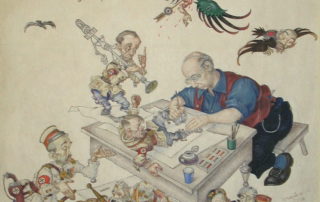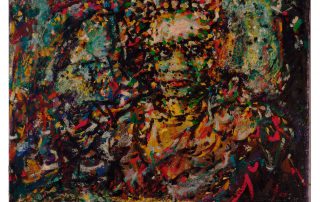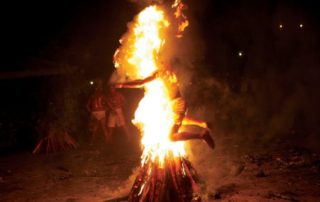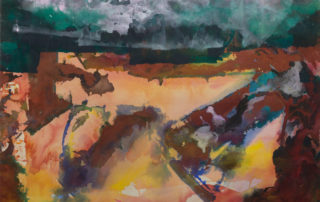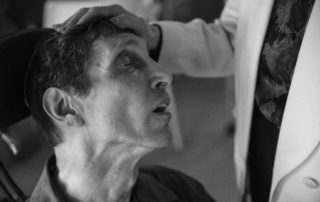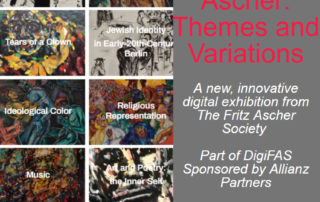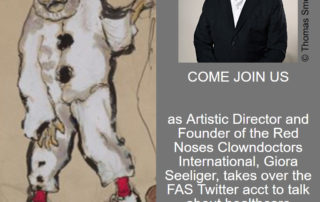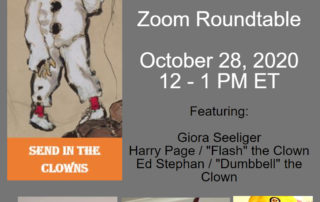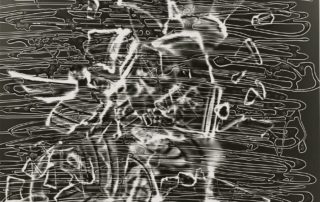Rachel Stern2022-02-18T06:31:18-05:00February 17th, 2021|Events, Lectures, Past Events|
During the first four decades of the twentieth century, Polish Jewish artist Arthur Szyk (1894–1951) was best known for his richly detailed book illustrations and magnificent illuminations on Jewish themes. He portrayed the Jews as a heroic nation that had resisted oppression through the ages and eventually triumphed. His Jews were fighters for their own freedom and the freedom of others. Szyk sought to redefine how the Jews viewed themselves and how others viewed them. His works thus challenged the notion that Jewish history was merely one long saga of suffering and, at the same time, refuted the then common antisemitic canard that the Jews were a cowardly people. With the coming to power in Germany of Adolf Hitler [...]
Rachel Stern2022-02-18T07:19:09-05:00January 11th, 2021|Events, Lectures, Past Events|
WATCH THE RECORDING OF THIS EVENT HERE. Visual art during and after the Holocaust, by victims and survivors eloquently contradicts the famous comment by Theodor Adorno that "after the Holocaust to make art is barbaric." On the contrary, it was and is necessary: as part of the record of events as they were transpiring, and as part of the human response to horror--to express anger, to raise questions, to offer healing--in the time after those events. Who creates the art and what kind of art is created? What role does it play in wrestling with the question of what God is and what we humans are? These issues have implications both from within the heart of the Holocaust and from well beyond its particular boundaries. [...]
Rachel Stern2022-02-18T07:13:15-05:00December 3rd, 2020|Events, Lectures, Past Events|
Oskar Nerlinger (1893-1969) was one of the most important artists of the committed art scene in the Weimar Republic. He was a member of the Association of Proletarian Revolutionary Art (ASSO for short), which was founded in 1928 and belonged to the KPD, which cooperated with the Soviet avant-garde artist group Oktober. At that time there was no conflict between positions of aesthetic modernism and KPD politics. In 1932 the political and artistic avant-garde in the Soviet Union fell apart, with serious consequences for left-wing artists in Germany. Almost at the same time, the Nazi system broke with all forms of modernity. With his idea of art suddenly doubly isolated within his own party, which followed Stalin's art verdict, [...]
Rachel Stern2021-01-11T06:14:12-05:00December 2nd, 2020|Events, Lectures, Past Events|
WATCH THE RECORDING OF THIS EVENT HERE. More information about Janice Biala is available HERE. Lecture featuring Jason Andrew Independent Scholar, Curator and Producer in New York Introduced by Rachel Stern Executive Director of the Fritz Ascher Society in New York Biala (1903-2000) was a Polish born American painter whose career stretched over eight decades and spanned two continents. Through it all, she retained an intimacy in her art rooted in Old World Europe—sensibilities that began with memories of her childhood in a Polish village, shaped by School of Paris painters like Bonnard, Matisse and Braque, inspired by Velázquez and the Spanish Masters, and broadened by the community of loft-living artists in Post World War II Downtown New York. Her [...]
Elizabeth Berkowitz2024-03-05T08:12:14-05:00November 18th, 2020|Exhibitions|
This digital exhibition includes important examples from the oeuvre of the German Jewish Expressionist artist Fritz Ascher (1893-1970). Ascher’s career extended from prior to the First World War until the late 1960s. However, Ascher’s artistic trajectory was interrupted due to persecution under National Socialism, and he spent much of the Second World War in hiding, concealed in a family friend’s basement. Ascher’s work consequently encompasses both the vibrant artistic scene in early-20th-century Germany, as well as the trauma and aesthetic shifts consequent of Ascher’s persecution and deprivations during the twelve years of the Nazi regime. These selected works are representative not only of critical moments in Ascher’s personal and artistic development, but also of key themes that occupied Ascher’s [...]
Rachel Stern2020-11-25T16:10:20-05:00October 28th, 2020|Events, Memory, Past Events|
WATCH THE RECORDING OF THIS EVENT HERE. Conversation featuring Kitra Cahana, Documentary Photographer, Videographer and Photo/Video Artist and Ori Z Soltes, Teaching Professor at Georgetown University in Washington DC Introduced by Rachel Stern, Executive Director of The Fritz Ascher Society in New York NY Kitra Cahana's award winning work ranges from photographic studies of American Teens for National Geographic Magazine to documentaries on the annual life-saving dance competition in a small town in northern Canada. She is renowned for work that consistently reflects a deep sense of empathy with her subjects. Her grandmother was a teen-aged Holocaust survivor who became an intense and powerful painter. Her father, a rabbi and a poet, was severely disabled by a stroke at the [...]
Rachel Stern2020-11-18T14:34:57-05:00October 27th, 2020|Events, Memory, Past Events|
WATCH THE RECORDING OF THIS EVENT HERE. Lecture featuring Ori Z Soltes, Teaching Professor at Georgetown University in Washington DC Moderated by Rachel Stern, Executive Director of the Fritz Ascher Society in New York This lecture explores several interlocking themes. The work of three artists, each in a different medium—Alice was primarily a painter, Ronnie is a poet, and Kitra is a well-recognized photographer and filmmaker—will be presented and explored with regard to both aesthetic and conceptual intentions and outcomes. Since these three artists represent three generations from within one family, the question of how that familial relationship does or does not impinge on the artistic output will be explored. Inevitably, the fact that the first of the three was a [...]
Rachel Stern2020-11-12T11:42:45-05:00October 18th, 2020|Events, Memory, Past Events|
WATCH THE RECORDING OF THIS EVENT HERE. In this interdisciplinary conference, four experts discuss the transmission of Holocaust trauma and memory against the backdrop of art. The starting point of the discussion is the art of Holocaust survivor Alice Lok Cahana and how artistic sensibilities, traumatic memory—and a sense of obligation to improve the world—have been expressed through three generations of her family—both in who her children and grandchildren are and in how they express themselves artistically. The discussion will amplify this layered issue from other angles: what have recent biological and psychological investigations offered, regarding what memory is and how it works, if and how trauma can be carried in the DNA—and the implications of all of this for [...]
Rachel Stern2020-11-24T20:14:35-05:00October 14th, 2020|Newsletter|
Dear Friends, On October 17 we celebrate Fritz Ascher’s birthday - this year with the launch of DigiFAS - diverse, innovative digital initiatives that provide new ways of engagement with the art and life of artists persecuted by an authoritarian regime. DigiFAS is generously sponsored by Allianz Partners. This launch includes the Society’s first-ever fully digital exhibition “Fritz Ascher: Themes and Variations.” You can explore the exhibition HERE. We have worked on this for months and can’t wait for your reactions! We also invite you to participate in the 2- week digital engagement project “Send in the Clowns,” which explores the clown as a figure between tragedy and comedy, between self- identification [...]
Rachel Stern2020-11-02T20:09:58-05:00September 30th, 2020|Events, Past Events, Send in the Clowns|
Twitter @Ascher_Society Giora Seeliger, Artistic Director and Founder of Red Noses Clowndoctors International, takes over the FAS Twitter account to answer your burning questions about clowning, the role of a healthcare clown, and anything else that comes to mind! Submit your questions in advance by writing to info@fritzaschersociety.org Part of "Send in the Clowns," an interactive two-week digital initiative, which explores the clown as a figure between tragedy and comedy, between self- identification and stage--a character designed to (literally) mask the performer’s true feelings behind a facade of happiness. “Send in the Clowns” uses the prominence of the “clown” figure in Fritz Ascher’s work as a lens through which to explore the duality of the clown both historically and today. [...]
Rachel Stern2020-10-28T14:24:47-04:00September 30th, 2020|Events, Past Events, Send in the Clowns|
Watch the recording of this event HERE. Roundtable featuring Giora Seeliger Artistic Director and Founder of the Red Noses Clowndoctors International Harry Page “Flash” the Clown Ed Stephan “Dumbbell” the Clown Moderated by Elizabeth Berkowitz Art Historian and Digital Interpretation Manager, The Fritz Ascher Society in New York One of the more appealing aspects of the clown subject to artists like Fritz Ascher was the divide between a public persona committed to joy and happiness, and the pain or sadness that might lurk beneath the real, human surface. Hospital or healthcare clowns straddle this divide every day of their professional lives—working to bring happiness to child patients who are often in circumstances that might otherwise inspire grief or pain. This [...]
Rachel Stern2022-03-06T11:39:32-05:00September 30th, 2020|Events, Lectures, Past Events|
Lecture by Lynette Roth Daimler Curator of the Busch-Reisinger Museum and Head of the Division of Modern and Contemporary Art at the Harvard Art Museums Moderated by Rachel Stern Executive Director of the Fritz Ascher Society in New York Anneliese Hager (1904-1997) is one of a number of modern artists who began their artistic experimentation in Germany after National Socialist cultural policy began to harden against all forms of modern art. Her preferred medium was the photogram, a photographic image made by placing an object directly on (or in close proximity to) a light-sensitive surface and exposing it to light. Hager called the reversal of light and dark in the resulting contact print “white shadows.” [...]


